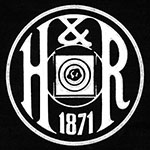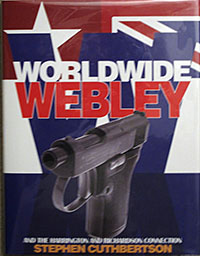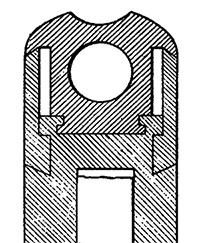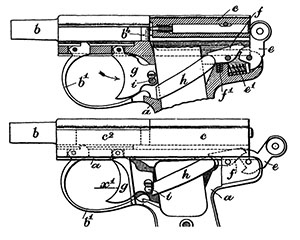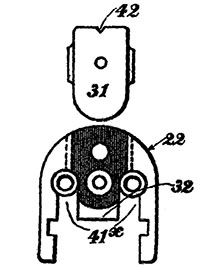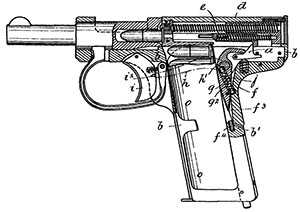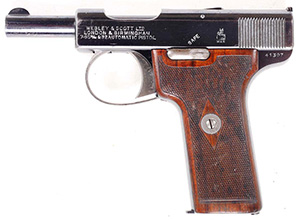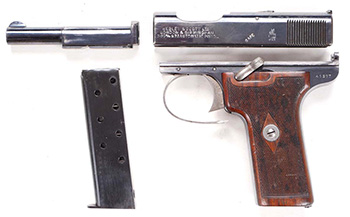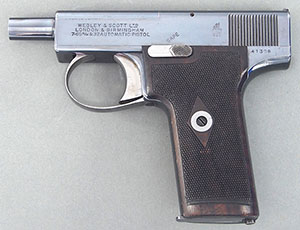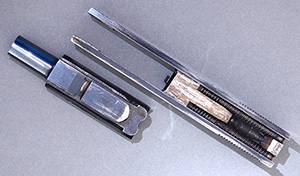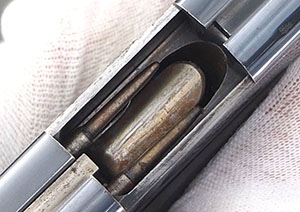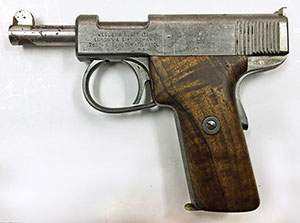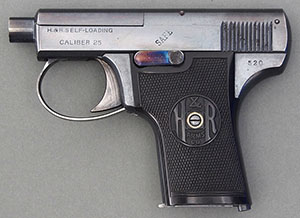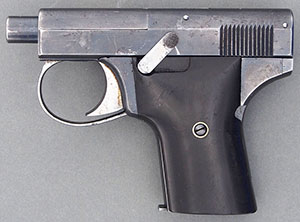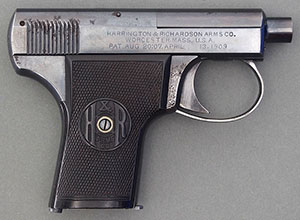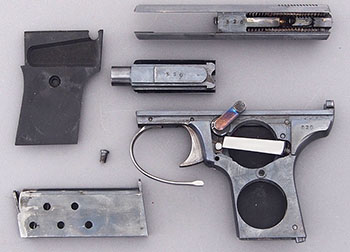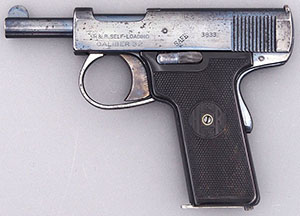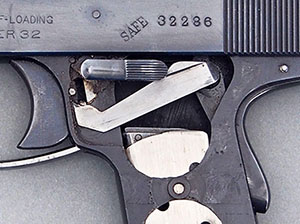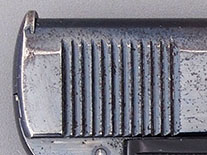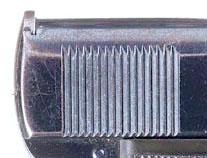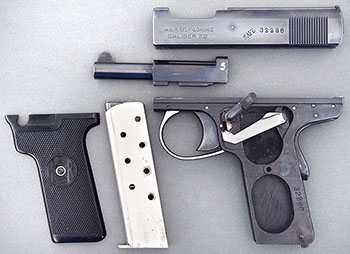 |
|||||||||||||||||||||||||||||||||||||||||||||||||||||||||||||||||||||||||||||||||||||||||||||||||||||||||||||||||||||||||||||||||||||||||||||||||||||||||||||||||||||||||||||||||||||||||||||||||||||||||||||||||||||||||||||||||||||||||||||||||||||||||||||||||||||||||||||||||||||||||||||||||||||||||||||||||||||||||||||||||||||||||||||||||||||||||||||||||||||||||||||||||||||||||||||||||||||||||||||||||||||||||||||||||||||||||||||||||||||||
 |
|||||||||||||||||||||||||||||||||||||||||||||||||||||||||||||||||||||||||||||||||||||||||||||||||||||||||||||||||||||||||||||||||||||||||||||||||||||||||||||||||||||||||||||||||||||||||||||||||||||||||||||||||||||||||||||||||||||||||||||||||||||||||||||||||||||||||||||||||||||||||||||||||||||||||||||||||||||||||||||||||||||||||||||||||||||||||||||||||||||||||||||||||||||||||||||||||||||||||||||||||||||||||||||||||||||||||||||||||||||||
|
The Harrington and Richardson by Ed Buffaloe
At this time, only Colt’s was producing automatic pistols in the United States. H&R was a well-known maker of economical shotguns and revolvers, and likely saw an opportunity to compete with Colt’s for the lower end of the market. Whiting had just filed his first patent for an unlocked-breech self-loading pistol on 4 August of that year, and limited production of the gun in .32 caliber had begun in late September 1905. We may presume that this early discussion with H&R was about the manufacture of a pistol in .32 caliber, since the .25 caliber cartridge was not yet on the market. We do not know if Whiting had an example of his new .32 pistol to show Harrington when they met, but it seems likely. In any case no agreement was reached during this first meeting. (Remling states that a preliminary agreement was signed, but I can find no further evidence for this.) According to Cuthbertson, “...contact was maintained between the two companies.”
According to Cuthbertson: “In late 1909, after the United states Patent Office had granted Whiting’s patent for the sear linkage [on 13 April 1909], Harrington & Richardson and Webley & Scott Ltd. signed a formal licensing agreement.” Not long after this, Webley & Scott built two prototype pistols based on Whiting’s 1908 patents; one of these prototypes may have gone to H&R (see below). However, production of the H&R .25 caliber automatic pistol did not begin until 1912. Exactly which pistols Whiting took to the U.S. late in 1908 is open to question. I had assumed he took one or another of the prototype pistols discussed below, but Gordon Bruce states (on pages 154 and 282) that serial numbers 41307 and 41308 were manufactured in January 1910, so they were not taken to the U.S. in 1908, even though the patents upon which they are based were filed in September 1908. The unserialed prototype gun discussed below is of even later origin. Bruce says of Whiting’s 1908 design: “Despite the advantages offered by the new layout, Webley & Scott did not adopt the design for mass production...” He does not say why. Possibly the cost of retooling the production line was too great. In any case, the design that Webley & Scott licensed to H&R for their .25 caliber pistol dates from 1908 and, while based on his earlier designs, differs in many particulars.
British Patent 1908-18567 and U.S. Patent 918,406
British Patent 1908-23200
British Patent 1910-20367 This patent covers the design of a gun with twin recoil springs and guide rods, and a slide end-piece which retains the springs and guide rods, so the slide, springs, and rods can be removed as a unit. The previous two patents omit any description or depiction of recoil absorption. The closure piece at the end of the slide also serves as the rear sight. The patent drawing shows a small, vest-pocket sized handgun nearly identical to the “hammerless” Webley & Scott 6.35mm M1912. There is no corresponding U.S. patent. The .25 caliber H&R pistol utilized the twin-recoil spring and guide rod concept but not the closure piece, opting instead for a round plug pinned in the end of the slide. The H&R pistol did not use the guide rods as ejectors. British Patent 1914-6954 This patent covers a spring steel trigger guard for a self-loading pistol with a lug at the front that locks the barrel to the frame and which also serves as a recoil buffer. Whiting refers to his earlier British patent 15,982 of 1905 for a similar trigger guard which was completely removable and which had a lug at either end, each of which fitted into recesses in the bottom of the barrel to retain it in the frame. The unforeseen problem with the fully removable trigger guard was that people sometimes misplaced it and also tended to try to put it in backward. The new patent has the trigger guard hinged at the rear, with a single lug at the front. British Patent 1914-6955 This patent covers a true hammerless pistol design with a single recoil spring in the upper portion of the slide, which also contains a spring-loaded striker which serves as the ejector. The patent drawing shows a pistol with a grip-safety, which is specified in the following patent. The previous and subsequent patents were all submitted together on 19 March 1914, prior to the advent of World War I later that year, and all three patents were apparently intended to be licensed to H&R for their .32 caliber pistol.
British Patent 1914-6956 This patent covers the grip safety which also serves as a magazine safety. The upper portion of the grip safety lever curves backward and forms the release mechanism for the sear. When the magazine is withdrawn, the entire grip safety lever tilts forward and away from the sear. Additionally, if the magazine is inserted but the grip safety lever is not squeezed, the transfer bar tilts down so that it cannot engage the stud on the back of the trigger. When the grip safety is squeezed, the transfer bar is tilted upward to engage the trigger stud. There is no corresponding U.S. patent. U.S. Patent 1,119,124 This patent, filed by Frederick Smith and assigned to Harrington & Richardson, covers a magazine safety that locks the trigger when the magazine is withdrawn. It was filed on 21 November 1913 and was granted on 1 December 1914. Judging by the patent drawing, it was clearly intended for use in the .25 caliber H&R pistol, but as far as I can determine it was never implemented in a production pistol.
The gun has twin recoil springs in the lower portion of the slide, retained by a plate dovetailed into its rear, as shown in British patent 1910-20367. The open top of the slide serves as the ejection port. Ejection is accomplished by the guide rods
Other aspects of this gun are identical with the existing Webley & Scott standard .32 caliber Model 1908 pistol, including the design of the trigger guard which serves to lock the barrel in the slide, the design of the trigger, transfer bar and sear, the manual safety lever that acts on the transfer bar, and the magazine capacity of 8 rounds. As we will see below, this gun is actually quite different from the Harrington & Richardson .32 caliber auto pistol, despite its external resemblance. Not only does it not have a grip safety, but its recoil absorption method is different, its lockwork is different, and its trigger guard pulls out at the bottom rather than the front to release the barrel and does not serve to buffer recoil.
The upper portion of the slide is drilled to hold two recoil springs and guide rods. The slide serves as a cover for the internal hammer, holds the breech block with its integral firing pin, and has two arms that reach out toward the front of the gun on either side of the barrel. Unlike other designs with “open-top” slides, there is no crosspiece at the front to connect the two arms either above, in front of, or beneath the barrel. The two arms of the slide are thick, to prevent deformation, and the barrel, slide, and frame are connected via dovetail grooves, so the various components mutually support one another as the gun cycles. There is no need for an ejection port. The breech block butts right up against the rear of the barrel, and ejection is out the top in the space opened up when the slide recoils. Ejection is accomplished by the guide rods for the recoil springs, which are pointed on the front and protrude through holes on either side of the breech block. The extractor sits on top of the slide and also serves as a loaded chamber indicator, its rear end protruding from the slide on an empty chamber but sitting flush when it engages a cartridge. As described in British patent 1908-23200, the transfer bar is a part of the sear that extends forward to engage a stud on the back of the trigger when the hammer is cocked. When the hammer is not cocked, the transfer bar is held in a lower position and cannot contact the trigger stud. The manual safety lever locks the trigger. When the trigger is pulled, the trigger stud pushes past the transfer bar and cannot re-engage it until the trigger is released.
I had always thought that H&R took the basic Webley & Scott design and improved it with their superior engineering talent, but nothing could be further from the truth. H&R had no expertise in automatic pistol design. The H&R self-loading pistols are based entirely on designs by William Whiting licensed to them by W&S. H&R made only minor or cosmetic changes to the designs proffered by Whiting. An H&R employee, Frederick Smith, designed a magazine safety for the H&R .25, but it was never implemented in a production pistol.
The second patent referenced on the H&R .25 is U.S. Patent 918,406, which was granted to William Whiting on 13 April 1909. This is the legitimate patent which actually describes the H&R .25--a gun with an unlocked breech, an internal hammer, a transfer bar that is part of the sear and can only engage the trigger stud when the hammer is cocked, and interlocking dovetail connections between barrel, slide, and frame. The patent does not show the manual safety, which only serves to lock the trigger, though a safety of this type appears on the Webley & Scott prototype, serial number 41308, which was made in 1908 and which served as the prototype for the H&R .25 caliber pistol. Disconnection is accomplished at the trigger, when the trigger stud passes up past the transfer bar and cannot reconnect until the trigger is released. However, there is no mechanism to disconnect when the slide is out of battery. The closest thing that Webley & Scott ever made to the H&R .25 was the Model 1912 “hammerless”; both guns have an internal hammer, share a similar disassembly method, a magazine release, and have twin recoil springs. But the slide and lockwork are quite different, and the W&S lacks the interlocking dovetail grooves that hold the H&R together. Also, the W&S “hammerless” .25 uses the guide rods as ejectors, whereas the H&R uses its firing pin as the ejector. According to Gordon Bruce, the reason the lockwork on the H&R differs from the standard W&S lockwork is that Whiting was concerned that Colt’s might find his original design to infringe on one of its patents (see Bruce, page 286). Early Production H&R .25
An earlier gun with the serial number 35 has come to light. It is identical to this gun, but has the production H&R grips, and is inscribed on the left side of the slide in all capital sans-serif characters as follows: H&R AUTOMATIC On the right side of the slide are the company name and the patent dates. Gordon Bruce states, on page 289 of his book, that the very earliest guns had an incorrect patent date, which was later omitted. He does not state when the error was corrected, but I own serial number 246, which has the corrected dates. Please contact me if you have an early gun with a third patent date.* In any case, the earliest inscription is said to read, in all capital sans-serif characters: HARRINGTON & RICHARDSON ARMS CO. H&R .25 Caliber Self-Loading Variants Other than the few early guns with the square back and the incorrect patent date, there were no major changes to the .25 design throughout production; there were only very minor changes to inscriptions on both sides of the gun. On the left side of the slide, beneath the barrel, in small capital sans-serif characters, is the following inscription: H&R SELF-LOADING This same inscription was made with slightly larger lettering somewhere near serial number 8000. Toward the end of production, the position of this larger inscription was moved slightly to the rear. If you have a very early or very late H&R .25, please contact me.* The right side of the slide is marked as follows: HARRINGTON & RICHARDSON ARMS CO. Bruce’s explanation for the patent date error is that the date used, April 9, was that of the patent application rather than the date the patent was granted. The patent in question would have been U.S. patent 936,967, which was Whiting’s patent for the trigger guard barrel lock mechanism, filed on 9 April 1909 and granted 12 October 1909. Apparently, rather than have a new roll stamp cut, H&R simply ground away the incorrect date and continued using the stamp. Somewhere around serial number 8000* the company had a new roll stamp made, as follows: HARRINGTON & RICHARDSON ARMS CO.
Bruce states that: “It is also understood that the triggerguard on early models had been blued, rather than a polished metal finish.” The wording leads one to believe that he had not seen such a blued trigger guard himself, but serial number 35 appears to have one. Since the trigger guard is made of spring steel it may be that it did not hold bluing well, so the company resorted to polishing it instead; or perhaps the early trigger guards were heat treated to a blue color. The trigger guards on serial numbers 48 and 246 do not appear to have ever been blued by any method. The serial number is stamped on the left side of the frame behind the grip, and on the bottom of the barrel and slide. Cuthbertson states that production ended in 1916, with the last serial number being 16630. Goforth
states that the gun remained in the H&R catalog “...until at least 1918.” Goforth believes that
production ended because the gun was too expensive compared to the economical H&R revolvers; H&R revolvers sold for about half what the self-loading pistol cost. Still, H&R was undercutting
Colt’s: In
According to Cuthbertson, prototypes were made by Webley & Scott in 1914, and production began in April 1916. Presumably, this also marked the end of .25 caliber production. The H&R .32 is an unlocked-breech gun with the slide cut away on top to serve as an ejection port. A single coil spring with guide rod is mounted in the upper portion of the slide to dampen recoil and return the slide. Unlike the H&R .25 and all Webley & Scott auto pistols, this gun is striker -fired; it is a true hammerless pistol with an unusually large and heavy striker. The barrel and slide are held in place by a lug on the front of the trigger guard, which fits into a cut in the bottom of the barrel. Disassembly is accomplished by pulling down on the front of the trigger guard. The spring steel trigger guard also serves as a recoil buffer. The barrel moves a short distance, buffered by the trigger guard, before the slide recoils.
As with the H&R .25, the transfer bar is attached to the sear mechanism rather than to the trigger, and is activated by a stud on the back of the trigger. However, unlike the .25, disconnection on the .32 is accomplished when the recoiling slide depresses a raised area at the rear of the transfer bar, forcing the transfer bar out of alignment with the trigger stud. The breech block is pinned into the slide. The rear support block for the recoil spring and its guide rod and for the striker spring and its guide rod, is slotted into the back of the slide and held in place with an end plate secured with a spring and plunger. The left side of the slide is marked in all-capital sans-serif characters: H&R SELF-LOADING The right side of the slide is marked: HARRINGTON & RICHARDSON ARMS CO. The serial number is stamped on the left side of the slide, on the grip frame beneath the left grip, and on the bottom of the barrel. The finish is blue with a nickeled magazine. Grip plates are of checkered hard rubber with the H&R Arms Co. logo in the center. The magazine release mechanism is identical to that on the Webley & Scott pistols, with the minor exception that the pin that holds it in place extends out from the frame on either side in order to fix the position of the grip plates. H&R .32 Caliber Self-Loading Variants
Early guns, up to about serial number 2500 have twelve relatively coarse triangular-cut slide serrations. After this, slides with sixteen finer triangular-cut serrations were introduced. However, for an interim of up to 2000 pistols one may find both coarse and fine serrations intermixed. For instance, serial number 3190 has coarse serrations, 3237 has fine serrations, and 3833 has coarse serrations. Please write to me if you have a gun in this range to share photographs and information about your gun.* The earliest magazine followers were perfectly flat, though the vast majority of followers have a rear section sloped gently toward the back. Gordon Bruce states that later magazine followers “...were shaped to project about .062” (1.57mm) higher...to serve as a hold-open stop for the breechslide...after the last cartridge had been fired.” However, I have found no evidence that this is true. Cuthbertson clearly states: “No magazines platforms [sic] have been noted which held the pistol open after the last shot had been fired.” Though this was a feature of the prototypes that signals an empty magazine, I believe H&R chose not to implement it because it makes the magazine difficult to remove and, since the slide does not remain open once the magazine is removed, it is more of an impediment to reloading than a useful feature. Cuthbertson says: “Early sales of the .32 calibre H&R Self-Loading pistol were quite brisk. As Webley & Scott could not supply its buyers after 1914 due to its war-time commitments, H&R acquired some of its customers.” Indeed, a gentleman on the British Great War forum owns serial number 276, which he believes was likely a British officer’s private purchase sidearm. They also sold well during the war in Australia and Canada. According to Cuthbertson, production ended on 30 June 1924, with the final serial number being 34500. He also mentions a Siamese contract in the 1920’s for 500 pistols which were in a separate number sequence, S1 to S500. Cuthbertson relates that the H&R .32 was only a half-dollar cheaper than the 1903 Colt and ultimately did not sell well. According to Goforth, H&R continued selling guns from its remaining stock until 1940.
* Write to edbuffaloe@unblinkingeye.com. |
|||||||||||||||||||||||||||||||||||||||||||||||||||||||||||||||||||||||||||||||||||||||||||||||||||||||||||||||||||||||||||||||||||||||||||||||||||||||||||||||||||||||||||||||||||||||||||||||||||||||||||||||||||||||||||||||||||||||||||||||||||||||||||||||||||||||||||||||||||||||||||||||||||||||||||||||||||||||||||||||||||||||||||||||||||||||||||||||||||||||||||||||||||||||||||||||||||||||||||||||||||||||||||||||||||||||||||||||||||||||
|
|||||||||||||||||||||||||||||||||||||||||||||||||||||||||||||||||||||||||||||||||||||||||||||||||||||||||||||||||||||||||||||||||||||||||||||||||||||||||||||||||||||||||||||||||||||||||||||||||||||||||||||||||||||||||||||||||||||||||||||||||||||||||||||||||||||||||||||||||||||||||||||||||||||||||||||||||||||||||||||||||||||||||||||||||||||||||||||||||||||||||||||||||||||||||||||||||||||||||||||||||||||||||||||||||||||||||||||||||||||||
|
Copyright 2020 by Ed Buffaloe. All rights reserved. |
|||||||||||||||||||||||||||||||||||||||||||||||||||||||||||||||||||||||||||||||||||||||||||||||||||||||||||||||||||||||||||||||||||||||||||||||||||||||||||||||||||||||||||||||||||||||||||||||||||||||||||||||||||||||||||||||||||||||||||||||||||||||||||||||||||||||||||||||||||||||||||||||||||||||||||||||||||||||||||||||||||||||||||||||||||||||||||||||||||||||||||||||||||||||||||||||||||||||||||||||||||||||||||||||||||||||||||||||||||||||
|
|
|||||||||||||||||||||||||||||||||||||||||||||||||||||||||||||||||||||||||||||||||||||||||||||||||||||||||||||||||||||||||||||||||||||||||||||||||||||||||||||||||||||||||||||||||||||||||||||||||||||||||||||||||||||||||||||||||||||||||||||||||||||||||||||||||||||||||||||||||||||||||||||||||||||||||||||||||||||||||||||||||||||||||||||||||||||||||||||||||||||||||||||||||||||||||||||||||||||||||||||||||||||||||||||||||||||||||||||||||||||||
